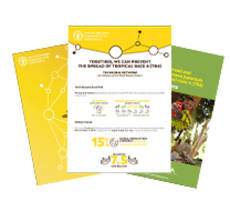Resources

Highlight
Together, we can prevent the spread of TR4
Investments in agriculture, including banana sector innovation, are crucial to increase the capacity for agricultural productivity, while sustainable food production systems are necessary in achieving #ZeroHunger. With a general public audience in mind, the brochure 'Together, we can prevent the spread of TR4' seeks to explain why bananas and plantains are essential crops around the world for both their economic importance and deep cultural roots. It also highlights the main ways to combat the spread of Tropical race 4 (TR4) which causes the disease Banana Fusarium Wilt (Banana FW).
Search resources
Extracellular DNA of Fusarium oxysporum f. sp. cubense as a Priming Agent for Inducing the Resistance of Banana Plantlets
01/02/2023
Evaluation of Soil Streptomyces spp. for the Biological Control of Fusarium Wilt Disease and Growth Promotion in Tomato and Banana
01/02/2023
Association of soil fungal community composition with incidence of Fusarium wilt of banana in Malaysia
31/01/2023
Effect of Salt Content (NaCl) on the Antagonistic Power of Gliocladium sp. in Inhibiting the growth of Fusarium oxysporum f. sp. Cubense Causes Fusarium wilt in Banana Plants
31/01/2023
Association of soil fungal community composition with incidence of Fusarium wilt of banana in Malaysia
31/01/2023
Biocontrol de Fusarium oxysporum f. sp. cubense con especies de Trichoderma sp.: una revisión
19/01/2023
Potential of Phylloplane Fungi from Mangrove Plant (Rhizophora apiculata Blume) as Biological Control Agents against Fusarium oxysporum f. sp. cubense in Banana Plant (Musa acuminata L.)
17/01/2023
The views expressed in this information product and the articles above are those of the author(s) and do not necessarily reflect the views or policies of FAO.


